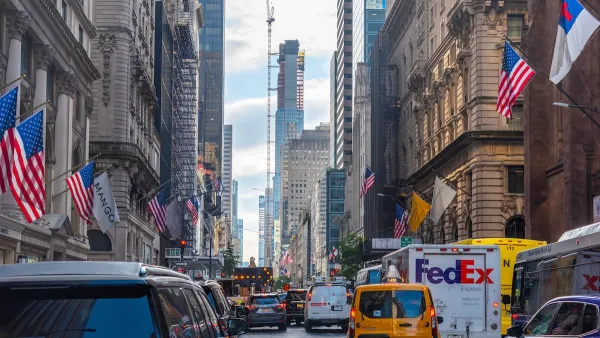"Push buttons" designed to protect pedestrians often don't.
A common sight, especially in suburbia, is the "push button" at an intersection. I come to an intersection and see a big button telling me to push it in order to cross the street. I push the button, and nothing happens. I push the button again and again. Eventually, the light turns red at the intersection and I cross, never knowing whether the button did any good.
I recently learned that the purpose of the button is not to make the light change more rapidly, but to give pedestrians more time to cross when the light does change. At one eight-lane street in Jacksonville, pedestrians have 49 seconds to cross if they push the button, and only 11 seconds otherwise. Needless to say, the combination of high-speed streets and short crossing times breeds pedestrian injuries: most recently, a woman was killed by a speeding vehicle while crossing the street on the way to Yom Kippur services.
It seems to me that these "push buttons" are not an ineffective way to improve pedestrian safety. As noted above, a push button often will not tell pedestrians what it does; thus, the pedestrian will not even know that the button gives the pedestrian more time. I do not see why the pedestrian should have to be an expert on traffic policy to have a decent amount of time to cross.
Instead, every pedestrian should have a decent amount of time to cross- at least 49 seconds, or better yet, 60 (as I saw at one Washington, D.C. intersection last month) seconds. Since cars routinely wait far more than 60 seconds to cross some intersections, it seems to me that 60 seconds should be a normal traffic-light time, button or no button.
Another improvement (recently enacted at Jacksonville's intersection of death) is to create a countdown clock, so that the pedestrian knows how much time he has to cross. Whether the pedestrian has 11 seconds or 60, he should at least know how risky his trip is.
But even with long crossing times, a pedestrian still risks her life when crossing the street for another reason: just because the pedestrian has the light on her side does not mean there are no cars coming at her. Here in New York, when I see a "Walk" sign at a north-south avenue sign I only know that I need not fear a car coming southbound or northbound- but I am still fair game for cars making left and right turns. For these cars, the light is still green. One solution to this problem is to have "four-way" stops where (at least for a few seconds) the light is red for motorists making turns as well as those who are driving straight through an intersection.

Maui's Vacation Rental Debate Turns Ugly
Verbal attacks, misinformation campaigns and fistfights plague a high-stakes debate to convert thousands of vacation rentals into long-term housing.

Planetizen Federal Action Tracker
A weekly monitor of how Trump’s orders and actions are impacting planners and planning in America.

Chicago’s Ghost Rails
Just beneath the surface of the modern city lie the remnants of its expansive early 20th-century streetcar system.

Bend, Oregon Zoning Reforms Prioritize Small-Scale Housing
The city altered its zoning code to allow multi-family housing and eliminated parking mandates citywide.

Amtrak Cutting Jobs, Funding to High-Speed Rail
The agency plans to cut 10 percent of its workforce and has confirmed it will not fund new high-speed rail projects.

LA Denies Basic Services to Unhoused Residents
The city has repeatedly failed to respond to requests for trash pickup at encampment sites, and eliminated a program that provided mobile showers and toilets.
Urban Design for Planners 1: Software Tools
This six-course series explores essential urban design concepts using open source software and equips planners with the tools they need to participate fully in the urban design process.
Planning for Universal Design
Learn the tools for implementing Universal Design in planning regulations.
planning NEXT
Appalachian Highlands Housing Partners
Mpact (founded as Rail~Volution)
City of Camden Redevelopment Agency
City of Astoria
City of Portland
City of Laramie






























